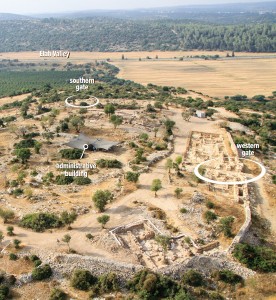King Herod the Great

King Herod the Great, originally appointed by the Roman Senate, ruled Judea for decades from 37 B.C.E. until his death in 4 C.E. Though he spawned a dynasty, including four descendants who appeared in the New Testament of the Bible, his greatest personal impact may have been the grandiose architectural projects he conducted, from the many palace-fortresses he constructed throughout Judea to the rebuilding and expansion of the Second Temple in Jerusalem. Herod’s Temple was not only the Temple that Jesus knew, but also via the Western Wall, the Temple we know today.
In this BAS Library special collection of Biblical Archaeology Review articles, read about Herod the man, the cruelty that defined his rule, and his horrific demise. Also, learn about the archaeological examinations of his building, and the Roman-inspired style that came to be known as “Herodian.”
Scroll down to read a summary of these articles.
Building Power
BAR, Sept/Oct 2002
by Kenneth G. Holum
Herod’s Roman Temple
BAR, Mar/Apr 2002
by David Jacobson
Wooden Beams from Herod’s Temple Mount: Do They Still Exist?
BAR, May/June 2013
by Peretz Reuven
Reimagining Herod’s Royal Portico
BAR, Jul/Aug/Sept/Oct 2019
by Orit Peleg-Barkat
Searching for Portraits of King Herod
BAR, Nov/Dec 2019
by Ralf Krumeich and Achim Lichtenberger
Herod’s Horrid Death
BAR, Mar/Apr 2002
by Nikos Kokkinos
Was Herod’s Tomb Really Found?
BAR, May/June 2014
by Hershel Shanks
The importance of architecture often goes beyond aesthetics, it is not only a manifestation of power but a means of extending and protecting it. In "Building Power," Kenneth G. Holum takes the excavations of Caesarea's harbor, built by King Herod, to explore both its many cultural uses and the suggestions of how it may have solidified Herod's power and that of his descendants in the Herodian dynasty.
The Second Temple was Herod's greatest impact, the construction project for which he is most remembered. A millennium after King Solomon's Temple, the First Temple, had been built, King Herod undertook his building inspired by Solomon, but with strong Greco-Roman influences on the style of the building itself. In "Herod's Roman Temple" David Jacobson explores Herod's building project and what motivated him as he completed it.
After the Roman's destroyed the Second Temple in 70 A.D., what happened to the Cedar of Lebanon wooden beams that had been a part of it? Peretz Reuven, In "Wooden Beams from Herod's Temple Mount," attempts to answer that question archaeologically, following the possible paths of re-use or destruction.
The expansion of the Portico was a massive undertaking, involving building up the Temple Mount itself before building construction could even take place. In "Reimagining Herod's Royal Portico," Orit Peleg-Barkat undertakes the difficult process of modeling what the Portico must have looked like in Herod's time.
King Herod followed the Jewish tradition of the time, not allowing depictions of his likeness in picture, on coin, or in statuary. However, outside of Judah, statues were raised in his honor. In "Searching for Portraits of King Herod," Ralf Krumeich and Achim Lichtenberger attempt to discover what can be known about Herod's appearance from the scanty evidence that remains.
"Herod's Horrid Death," looks at what is known of King Herod's demise. In addition to speculating about what disease might have killed him, Nikos Kokkinos examines the aspects of Herod's long, cruel reign that led some to feel his terrible death was a sort of poetic justice.
King Herod was buried at Herodium—a fact recorded by Josephus in the first century—but where precisely? In a BAR article published in 2011, archaeologist Ehud Netzer reported that he had found the tomb, but now others are calling his identification into question. In "Was Herod's Tomb Really Found?", Hershel Shanks examines the evidence and weighs in as the hunt for Herod’s tomb continues.
